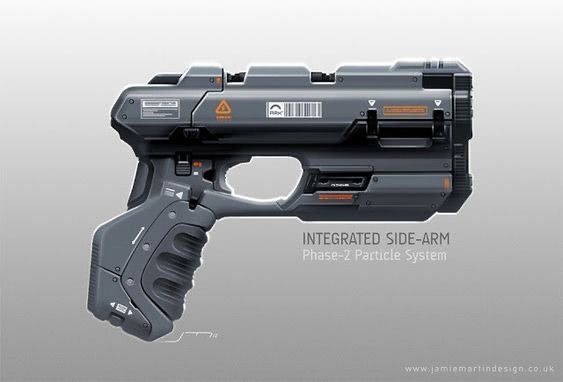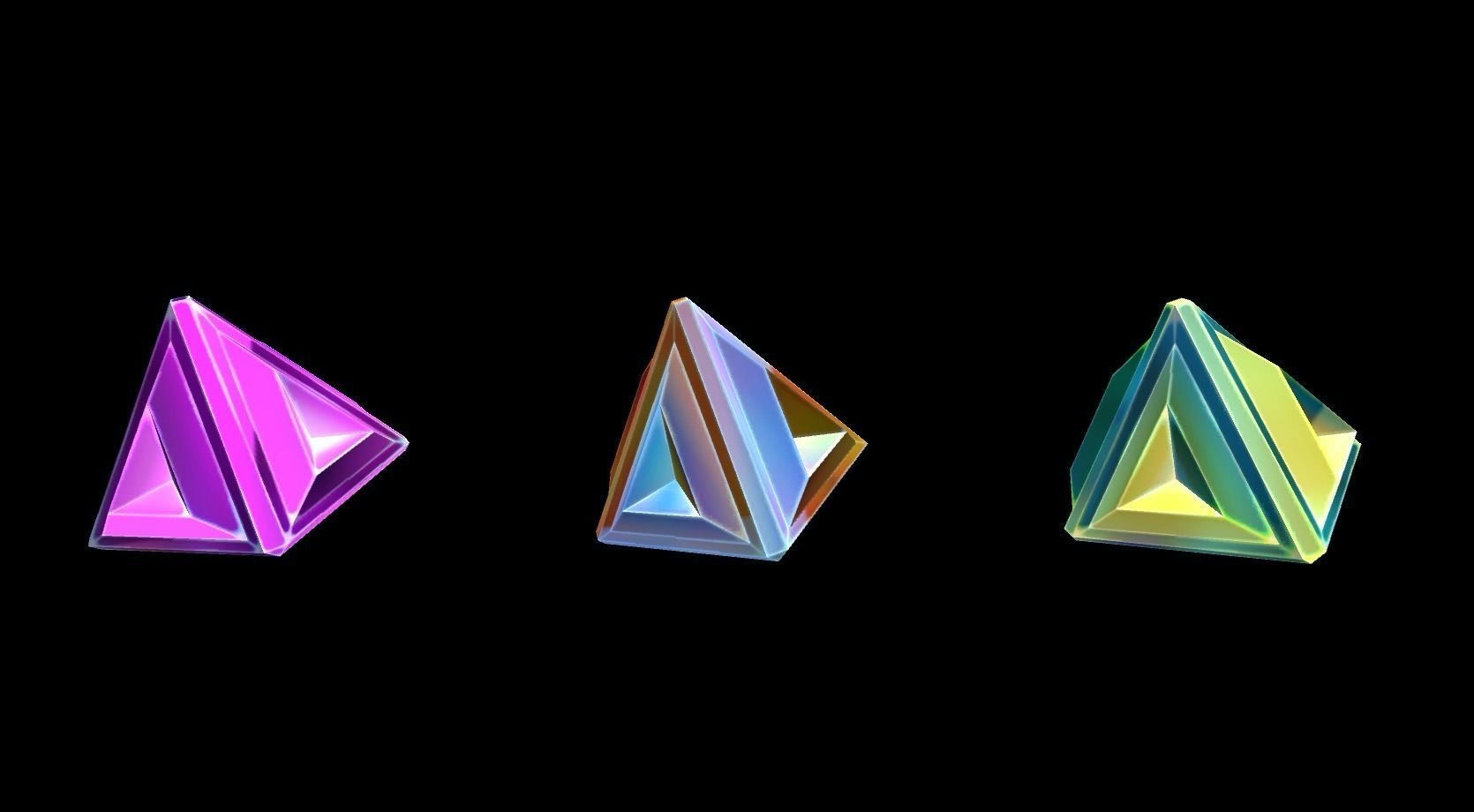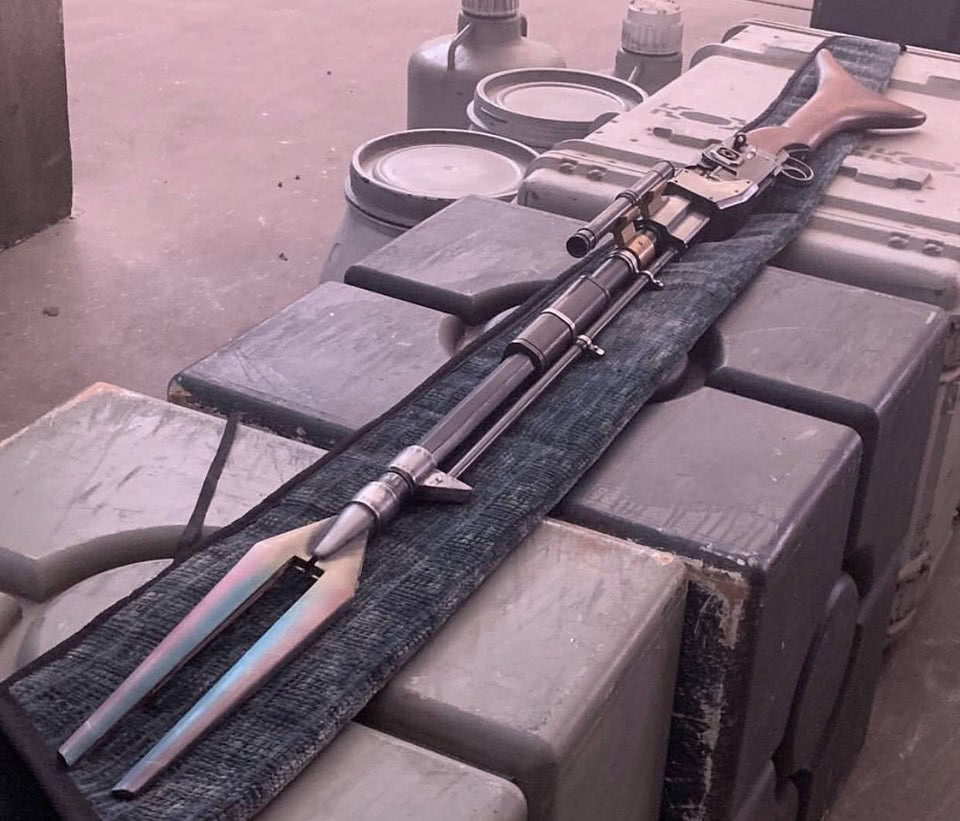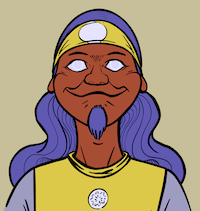Out of the box, Cypher comes with super simple weapon rules. Three categories (light, medium, and heavy) that do 2, 4, and 6 damage, respectively. Let’s get hacking and create some fantastic new weapons.
Before we dive into complicating our armaments, let’s open up the base design and see what is inside.
Cypher System weapon rules contain two big design thoughts - false precision and pace. We might define false precision as an increase of abstraction in order to distill meaningful choices. This distillation, in turn, helps immensely with the pace of the game.
I tried to retain these two design principles in my weapon hacks. If I add complexity, it needs to include a solid, meaningful choice, and be easy to use and track, so it doesn’t affect the pace of the game much.
Sci-Fi/Cyberpunk gun
If you run a hard sci-fi or a cyberpunk game that is low on magic, you will need exciting weapons and equipment. This weapon is meant to be handled as an artifact. It’s rare, can’t be bought, and needs to be stolen or earned through a quest. The first thing I wanted with this weapon is to avoid counting bullets but retain the possibility that it will stop firing. To that end, I introduce the concept of “charges.” Charges are depletion dies, and you roll them only when you want to use unique effects. When rolled, they show both the impact of the effect and if the charge is depleted. Charges are most likely expensive to find or produce. With this in place, we have our meaningful choice “Should I use a special effect and risk a depleted charge?” and we avoid bookkeeping by using actual dice. Mods are there to allow a user to customize the piece to better suit their needs. Mods should introduce a significant change to the operation of the weapon.
Pflager Katsumata Series-4 Blaster (Very Expensive)

Damage: 4
Range: Short
Size: Light
Charges: 3 x d4
Fire Modes: Single, Burst
Mod Slots: 3
Overload: When all charges are used at once, the weapon needs 1 round to cool before it can be reloaded and used again.
Fire Modes
Single: As long as there is at least one charge in the weapon, it can sustain a single fire mode. One attack per round for 4 damage. Depletion: –
Burst: Attack is hindered. Roll a d4 charge and add to the damage, if 1 also discard the charge. Appropriate skills like weapon handling can help with the attack.
Training eases the attack at close range, and specialized eases the attack up to short range.

Mods
Barrel: Increases range to long. Disables burst mode.
Grav Release: Firing in zero-G will not launch you in the other direction. Damage is halved.
Silencer: Decreases range to close. Shots are loud as a finger snap.
AR: Shoots where you look, not where you aim. The attack is hindered.
Charge Grip: Additional charge. When overloaded jams with a chance to explode.
Biometrics: Only you can use the weapon, and it will never shoot at you. Unless hacked.
Special Charge Types:
Kinetic: This charge pierces armor. Roll the charge die for bonus damage. Total damage ignores armor. On 1 discard the die.
Painter: Paints the target so that any cover or environmental hindrance is negated, as new rounds coming from the weapon are now seeking it. Does no damage. Roll the charge die to determine the number of rounds the target is painted. On 1 discard the die.
Tracker: Use two entangled quantum charges to implant a tracker. After the first one is fired, load the second charge into a tracker fob to get a tracking signal on the target. Does no damage. Discard both dies.
EMP: Use this charge to disable shields or one electronic system on the target. Roll the charge die to determine the number of rounds system is disabled. Does no damage. On 1 discard the die.
EXP: Explosive charge bursts on impact. Does no added damage but causes lasting damage to the target. Shields and armor protect double against this type of charge. On 1 discard the charge.
Fantasy sword
I created this weapon for a Numenera game. A player complained about how boring his bow was when everyone else had some science-fancy weapons. I made him an artifact “sword-bow” weapon that can instantly switch between melee and ranged modes.
Mechanically, the main difference between melee and ranged attacks is that firing from range is safer. All things being equal, a ranged attack will always be a better tactical choice for a player. As long as they have ammo, that is. In the barest mechanical sense, we can say that a player is exchanging ammo for not being hit (or at least harder to hit). To solve this part, I introduced a depletion die on ranged attacks. Depletion dice are generally not an ideal solution for counting ammo, but this is an artifact in a Numenera game, where a depletion die works well and has a fictional coverage, so we are good.
With the ranged mode depletion in place, I needed a way to recharge the weapon. I didn’t want to introduce crafting rules here and thought that a more elegant solution was to make it so that the weapon “eats” cyphers. This idea has two benefits compared to the core Destiny crafting rules. First is that it’s narratively more interesting, and second is that we are adding another layer of meaningful decisions for the player. Once emptied, a player will need to decide which cypher to sacrifice in order to power up the ranged mode again.
One more exciting thing we can do with a depletion die is to “burn” it. In other words, deplete an artifact on purpose for a more significant effect. For the Geminus, I set it up so that a player can choose to burn the die for additional melee damage that scales with the size of the die.
The reasoning behind it is that now that we know the weapon is eating cyphers, we put up an incentive to spend the charges so that more cyphers are used up, which is always good. I also only applied the burn option to the melee mode so that a player has a meaningful decision to make. Should I burn the die, which will disable my ranged attacks for the sake of the added damage? Yes? No? An Interesting choice.
So to recap, we have meaningful and interesting decisions on:
- whether to use a safer, more powerful but depletable ranged mode
- which cypher to sacrifice to recharge the weapon
- whether to burn the depletion die for bonus melee damage
Quite a few interesting decisions for the wielder to make, and we didn’t introduce any additional crunch into the game! With all the mechanical stuff done, now we can focus on the flavor and narrative, and breathe some life into the weapon, complete with personality quirks. What we mostly have is an artifact that is dualistic in nature, so we can use various dualistic narratives to craft a story around it.
Some ideas:
- Twins
- Lovers
- Gemini ( horoscope)
- Dualism (religious, philosophical, ethical)
- Unreliable personality (check GMI ideas)
Geminus (Bow-sword)
Geminus is a medium sword at first glance, but at the will of the wielder can shift its form instantly and become a bow instead. Hence Geminus can be used both in melee and at range. Pia Enna, a former owner, swore that the weapon had a mind of its own.
Moon aspect (melee): 4 (slashing) damage, deplete for bonus energy DMG
Sun aspect (range): 6 (energy) damage, roll depletion die on each use
Geminus is powered by cyphers. Depending on the level of a cypher it eats, it’s depletion die changes.
- Cypher level 4: 1 in d4 depletion
- Cypher level 6: 1 in d6 depletion
- Cypher level 8: 1 in d8 depletion
- Cypher level 10: 1 in d10 depletion
The Moon aspect allows the wielder to deplete the weapon for added damage. Roll the depletion die for bonus damage, or use the highest number on the die.
Salient Points
- Aspect change is instant.
- Depletion is tested only for ranged mode.
- Can’t be recharged if not depleted.
- Geminus is a medium weapon
- Geminus can sometimes get nervous, inconsistent, or indecisive
- Sun aspect is effective within long range
- Energy damage ignores armor
- Charging takes one action
- Its level depends on the cypher eaten
GMIs
- Eats random numenera owner is carrying
- Depletes and ends up stuck in one aspect
- Eats a cypher but is still hungry
- Doesn’t want to eat anything but level 10 numenera
- Eaten cypher effect manifests on an attack
- Fumbles
- Energy discharge burns a random cypher
- Depletes
- Stuck in one aspect
- Energy discharge burns the wielder
- Breaks and needs to be repaired
Mandalorian Rifle
Let’s create that awesome Mandalorian rifle bident! Up to episode three, we got to see several functionalities:
- Melee mode with and without electroshock.
- Range finder
- Heat vision
- Sound amplifier.
- Disintegrator ammo
Amban phase-pulse blaster

Level: 5
Damage: 4
Price: Very Expensive
Size: Medium
No. of charges: 6 x d4
Mod Slots: 3
Mods Installed: Range Finder (+1 range increment), Heat Signature, Sound Amp
Attacks: Melee, Melee Electroshock, Ranged Attack, Disintegration
Light Melee Attack: 2 DMG (no depletion roll). The attack is eased.
Melee Electroshock: Roll the charge die for additional electro damage. (Attack not eased). Discard on 1.
Ranged Attack: 4 damage at long range (very long with Range Finder). Depletion 1 in 1d4
Ranged Disintegration: Burn the depletion die for an additional 4 DMG at a long range (very long with Range Finder). Total DMG ignores armor. Reload time: 1 round.
I hope these examples inspire you to create your own Cypher weapons and artifacts. Have fun!


Comments